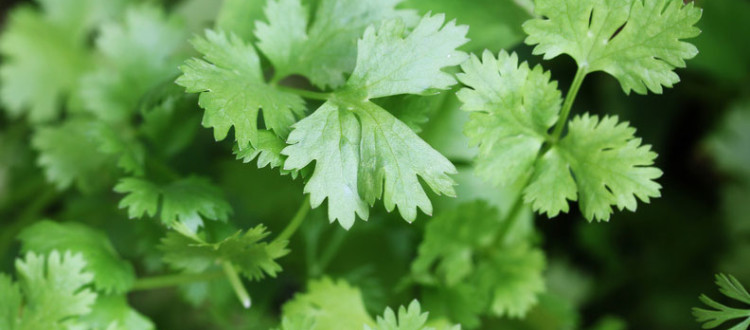Cilantro
Cilantro (Coriandrum sativum) is technically an perennial herb but is normally grown as an annual that can reach up to 15 inches in height in a single season. If allowed to continue growing, cilantro can reach five feet in height and produces a small white or pink flower followed by numerous seeds called coriander, that taste nothing at all like cilantro.
The leaves of cilantro are dark green, irregularly shaped; they’re broad at the base and have a crisp, citrusy taste that make it a popular ingredient in Mexican, Caribbean and Indian dishes. All parts of the plant are edible, including the flowers and seeds.
How to Plant
Cilantro thrives in cool weather, well-drained soil with full sun. A fast grower, cilantro will begin to flower and begin producing seeds (coriander) if the leaves aren’t clipped back frequently using scissors. Avoid harvesting more than one third of the plant at a time. Let the soil dry out to avoid overwatering. Fall is an excellent time to plant cilantro in the central California area, (USDA Zones 8, 9 and 10). Plant 12 to 18 inches apart. One planting strategy is to plant new plants every 3-4 weeks in the fall to provide a steady harvest of leaves in the spring and summer before the plant bolts and begins to flower.
Cilantro is susceptible to white flies and aphids, wilt and mildew. Be sure to remove dead cilantro plants to treat or prevent mildew and wilt. Use organic insecticide soaps to treat for insect infestation. Remove entire plant if insect problems persist.
Fertilizing
Cilantro grows through its cycle very quickly. If you begin with a good, fertile soil mix cilantro will not require fertilization until it’s gone through its cycle several times. Fish emulsions an excellent fertilizer for cilantro and can be applied after 4-5 cycles.
Harvesting
In mild winter climates cilantro can be grown and harvested year round. Clip the stem near its base once it reaches 6 to 12 inches in height. Avoid harvesting more than a third of the plant at a time. If the plant has begun to flower, cut the brown seed heads off and place them in a paper bag. After a few days the pods will break open and release the seeds.
Recommendations for Use
- Cilantro is a key ingredient in Mexican, Caribbean and Indian cuisine
- Use cilantro with seafood and chicken dishes
- Add to salsas, tacos, Mexican salads, black beans, shrimp ceviche
- Coriander seeds are used in Indian and Thai curries
- Fresh cilantro leaves and dried coriander seeds are not interchangeable — each has a distinct flavor and is used in its own way
Recipes: Cilantro Pesto, Creamy Cilantro Dressing

